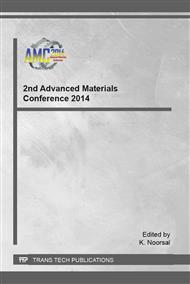[1]
D. Wang, Y. Li, X.M. Xie, B.H. Guo, Compatibilization and morphology development of immiscible ternary polymer blends, Polymer 52 (2011) 191-200.
DOI: 10.1016/j.polymer.2010.11.019
Google Scholar
[2]
S. J. Kim, B.S. Shin, J.L. Hong, W.J. Cho, C.S. Ha, Reactive compatibilization of the PBT/EVA blend by maleic anhydride, Polymer 42 (2001) 4073-4080.
DOI: 10.1016/s0032-3861(00)00810-7
Google Scholar
[3]
H. Cartier and G.H. Hu, A novel reactive extrusion process for compatibilizing immiscible polymer blends, Polymer 42 (2001) 8807-8816.
DOI: 10.1016/s0032-3861(01)00317-2
Google Scholar
[4]
C. Chevallier, F. Becquart, M. Taha, Polystyrene/polycarbonate blends compatibilization: Morphology, rheological and mechanical properties, Materials Chemistry and Physics 139 (2013) 616-622.
DOI: 10.1016/j.matchemphys.2013.02.006
Google Scholar
[5]
W. Feng and A.I. Isayev, In situ compatibilization of PP/EPDM blends during ultrasound aided extrusion, Polymer 45 (4) (2004) 1207-1216.
DOI: 10.1016/j.polymer.2003.12.033
Google Scholar
[6]
M.F. Diaz, S.E. Barbosa, N.J. Capiati, Reactive compatibilization of PE/PS blends. Effect of copolymer chain length on interfacial adhesion and mechanical behavior, Polymer 48 (2007) 1058-1065.
DOI: 10.1016/j.polymer.2006.12.040
Google Scholar
[7]
Q. Zhang, H. Yang, Q. Fu, Kinetics-controlled compatibilization of immiscible polypropylene/polystyrene blends using nano-SiO2 particles, Polymer 45 (2004) 1913-(1922).
DOI: 10.1016/j.polymer.2004.01.037
Google Scholar
[8]
Y. Chen, H. Zou, M. Liang, Y. Cao, Melting and crystallization behavior of partially miscible high density polyethylene/ethylene vinyl acetate copolymer (HDPE/EVA) blends, Thermochimica Acta 586 (2014) 1-8.
DOI: 10.1016/j.tca.2014.04.007
Google Scholar
[9]
M. Faker, M.K.R. Aghjeh, M. Ghaffari, S. A. Seyyedi, Rheology, morphology and mechanical properties of polyethylene/ethylene vinyl acetate copolymer (PE/EVA) blends, European Polymer Journal 44 (2008) 1834-1842.
DOI: 10.1016/j.eurpolymj.2008.04.002
Google Scholar
[10]
R.T. Tol, G. Groeninckx, I. Vinckier, P. Moldenaers, J. Mewis, Phase morphology and stability of co-continuous (PPE/PS)/PA6 and PS/PA6 blends: effect of rheology and reactive compatibilization, Polymer 45 (2004) 2587-2601.
DOI: 10.1016/j.polymer.2003.12.072
Google Scholar


